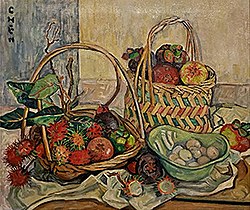
The Nanyang style of painting, also known as Nanyang art or the Nanyang school, was a modern art movement and painting tradition initially practised by migrant Chinese painters in Singapore from the late-1940s to 1960s.[1][2][3] As immigrant artists taken by the novelty of tropical landscapes, the Nanyang artists' works characteristically depicted Southeast Asian subject matter such as tropical fruit, kampung scenes, and batik fabric while drawing upon a synthesis of Western watercolor and oil painting techniques with Chinese ink traditions.[1][2][4][5]
The name of the movement draws from "Nanyang" (Chinese: 南洋; pinyin: nán yáng; lit. 'Southern Ocean'), a sinocentric Chinese term used to refer to Southeast Asia from the geographical perspective of China.[1][6][7] Nanyang art is seen as a significant period in Singapore's art history, as it demonstrates some of the early conscious attempts by artists based in Singapore to generate a local art discourse.[3]
Art historian Redza Piyadasa would identify Lim Hak Tai as a pioneer of this first generation of Nanyang artists.[8] The most famous of the Nanyang artists further include Liu Kang, Chen Chong Swee, Chen Wen Hsi, Cheong Soo Pieng and Georgette Chen, the first four of whom had received training in traditional Chinese watercolour painting in China.[6] Liu Kang and Chen Chong Swee arrived in Singapore during the 1930s before World War II, while Chen Wen Hsi and Cheong Soo Pieng would arrive in the post-war period.[2] Georgette Chen would arrive in Singapore in 1953, having previously been based in locations such as Paris, New York, Hong Kong, Shanghai, and Penang, holding exhibitions abroad and gaining international recognition before arriving in Singapore.[2]
- ^ a b c Balagopal, Roberta; Yeo, Alicia (31 August 2009). "The Nanyang Style". National Library Board. Archived from the original (article) on 10 March 2011. Retrieved 2010-08-06.
- ^ a b c d Susanto, Melinda (2015). "Tropical Tapestry". Siapa Nama Kamu? Art in Singapore Since the 19th Century. Singapore: National Gallery Singapore. pp. 30–41. ISBN 9789811405570.
- ^ a b Cite error: The named reference
:115was invoked but never defined (see the help page). - ^ "T.K. Sabapathy". Esplanade Offstage. 12 October 2016. Archived from the original on 27 February 2021. Retrieved 27 February 2021.
- ^ Sabapathy, T.K. (2010). Road to Nowhere: The Quick Rise and the Long Fall of Art History in Singapore. Singapore: The Art Gallery, National Institute of Education. ISBN 9810852649.
- ^ a b Ting Szu Kiong (2005). "Nanyang Art". Central Singapore Community Development Council. Archived from the original (article) on 2009-12-27. Retrieved 2010-08-06.
- ^ Yeo, Alicia (April 2006). "Singapore Art, Nanyang Style" (PDF). biblioasia. Singapore: National Library Board. pp. 4–11. Archived from the original (PDF) on 2012-02-27. Retrieved 2010-08-06.
- ^ Sabapathy, T.K. (2018). "The Nanyang Artists: Some General Remarks". Writing the Modern: Selected Texts on Art & Art History in Singapore, Malaysia & Southeast Asia 1973–2015. Singapore: Singapore Art Museum. pp. 340–345. ISBN 9789811157639.
